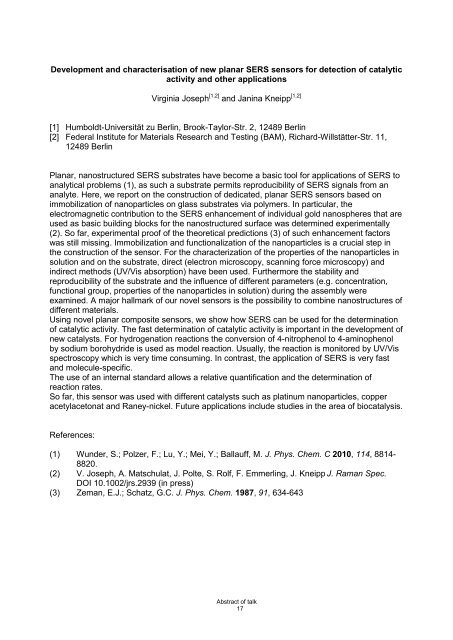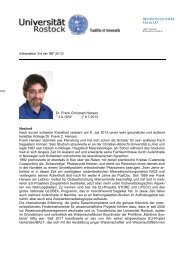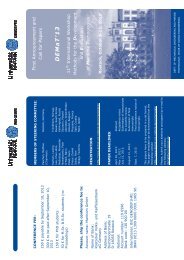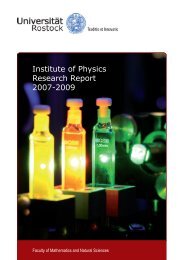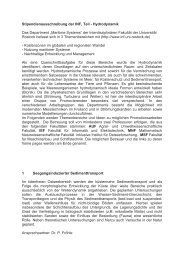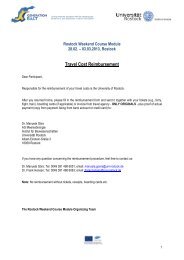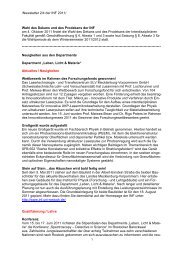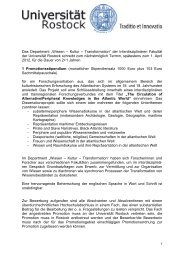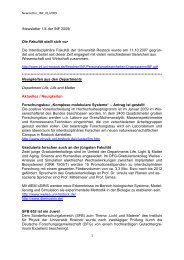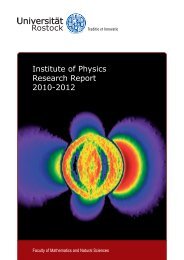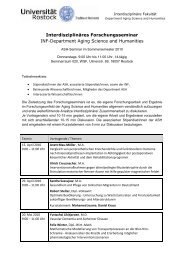Spectroscopy – Detective in Science Book of Abstracts - Universität ...
Spectroscopy – Detective in Science Book of Abstracts - Universität ...
Spectroscopy – Detective in Science Book of Abstracts - Universität ...
You also want an ePaper? Increase the reach of your titles
YUMPU automatically turns print PDFs into web optimized ePapers that Google loves.
Development and characterisation <strong>of</strong> new planar SERS sensors for detection <strong>of</strong> catalytic<br />
activity and other applications<br />
Virg<strong>in</strong>ia Joseph [1,2] and Jan<strong>in</strong>a Kneipp [1,2]<br />
[1] Humboldt-<strong>Universität</strong> zu Berl<strong>in</strong>, Brook-Taylor-Str. 2, 12489 Berl<strong>in</strong><br />
[2] Federal Institute for Materials Research and Test<strong>in</strong>g (BAM), Richard-Willstätter-Str. 11,<br />
12489 Berl<strong>in</strong><br />
Planar, nanostructured SERS substrates have become a basic tool for applications <strong>of</strong> SERS to<br />
analytical problems (1), as such a substrate permits reproducibility <strong>of</strong> SERS signals from an<br />
analyte. Here, we report on the construction <strong>of</strong> dedicated, planar SERS sensors based on<br />
immobilization <strong>of</strong> nanoparticles on glass substrates via polymers. In particular, the<br />
electromagnetic contribution to the SERS enhancement <strong>of</strong> <strong>in</strong>dividual gold nanospheres that are<br />
used as basic build<strong>in</strong>g blocks for the nanostructured surface was determ<strong>in</strong>ed experimentally<br />
(2). So far, experimental pro<strong>of</strong> <strong>of</strong> the theoretical predictions (3) <strong>of</strong> such enhancement factors<br />
was still miss<strong>in</strong>g. Immobilization and functionalization <strong>of</strong> the nanoparticles is a crucial step <strong>in</strong><br />
the construction <strong>of</strong> the sensor. For the characterization <strong>of</strong> the properties <strong>of</strong> the nanoparticles <strong>in</strong><br />
solution and on the substrate, direct (electron microscopy, scann<strong>in</strong>g force microscopy) and<br />
<strong>in</strong>direct methods (UV/Vis absorption) have been used. Furthermore the stability and<br />
reproducibility <strong>of</strong> the substrate and the <strong>in</strong>fluence <strong>of</strong> different parameters (e.g. concentration,<br />
functional group, properties <strong>of</strong> the nanoparticles <strong>in</strong> solution) dur<strong>in</strong>g the assembly were<br />
exam<strong>in</strong>ed. A major hallmark <strong>of</strong> our novel sensors is the possibility to comb<strong>in</strong>e nanostructures <strong>of</strong><br />
different materials.<br />
Us<strong>in</strong>g novel planar composite sensors, we show how SERS can be used for the determ<strong>in</strong>ation<br />
<strong>of</strong> catalytic activity. The fast determ<strong>in</strong>ation <strong>of</strong> catalytic activity is important <strong>in</strong> the development <strong>of</strong><br />
new catalysts. For hydrogenation reactions the conversion <strong>of</strong> 4-nitrophenol to 4-am<strong>in</strong>ophenol<br />
by sodium borohydride is used as model reaction. Usually, the reaction is monitored by UV/Vis<br />
spectroscopy which is very time consum<strong>in</strong>g. In contrast, the application <strong>of</strong> SERS is very fast<br />
and molecule-specific.<br />
The use <strong>of</strong> an <strong>in</strong>ternal standard allows a relative quantification and the determ<strong>in</strong>ation <strong>of</strong><br />
reaction rates.<br />
So far, this sensor was used with different catalysts such as plat<strong>in</strong>um nanoparticles, copper<br />
acetylacetonat and Raney-nickel. Future applications <strong>in</strong>clude studies <strong>in</strong> the area <strong>of</strong> biocatalysis.<br />
References:<br />
(1) Wunder, S.; Polzer, F.; Lu, Y.; Mei, Y.; Ballauff, M. J. Phys. Chem. C 2010, 114, 8814-<br />
8820.<br />
(2) V. Joseph, A. Matschulat, J. Polte, S. Rolf, F. Emmerl<strong>in</strong>g, J. Kneipp J. Raman Spec.<br />
DOI 10.1002/jrs.2939 (<strong>in</strong> press)<br />
(3) Zeman, E.J.; Schatz, G.C. J. Phys. Chem. 1987, 91, 634-643<br />
Abstract <strong>of</strong> talk<br />
17


